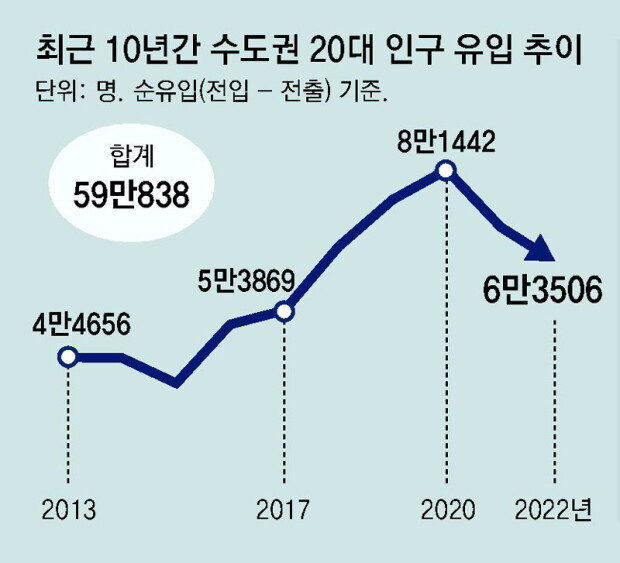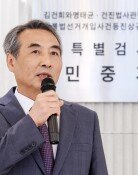Seoul sees 2.6-fold rise in twenty-something residents in a decade
Seoul sees 2.6-fold rise in twenty-something residents in a decade
Posted November. 08, 2023 08:04,
Updated November. 08, 2023 08:04

A 28-year-old Korean named Park, born and raised in Cheongju, North Chungcheong Province, moved to a small studio in Seoul in February this year. He aspired to open a café with a wide range of desserts in his hometown but decided to launch the business in Seoul, believing it would be more profitable. Park saved up his initial capital by working part-time in three local cafes in Cheongju. He felt compelled to start his business in Seoul due to its larger population and concentration of young residents.
A recent study indicates that over the past decade, as many as 600,000 people in their 20s have relocated from non-cosmopolitan regions to the Seoul metropolitan area. The trend of young individuals moving to the capital region appears to be accelerating, with the number of those leaving provincial areas increasing from 40,000 to a range of 60,000 to 80,000 over the past 10 years.
According to Statistics Korea, from 2013 to 2022, there was a net influx of 591,000 people in their 20s from provincial, non-cosmopolitan areas to cosmopolitan regions such as Gyeonggi Province, Incheon, and Seoul. It starkly contrasts that 312,000 individuals from other age groups relocated from the capital and nearby cosmopolitan areas to provincial regions during the same period. The 'net influx' is calculated by subtracting the number of those leaving from those arriving, and the 'net outflow' vice versa.
The influx of young adults into cosmopolitan areas gained momentum. The net inflow of people in their 20s increased from 45,000 in 2013 to 81,000 in 2020, then dipped slightly to 64,000 in 2022. Notably, the number of twenty-somethings moving to Seoul grew 2.6 times in a decade.
The area experiencing the most significant departure of people in their 20s was South Gyeongsang Province, with 105,000 departing in the last decade. North Gyeongsang Province followed closely, with 90,000 leaving, while South and North Jeolla Provinces saw 76,000 departures each, as did Daegu City (66,000 departures). The only provincial, non-cosmopolitan area with a positive net influx was Sejong, with 34,000 arrivals, attributed to ongoing development projects since its relaunch as an autonomous city in 2012.
One of the primary motivations for young adults leaving provincial areas for Seoul is employment opportunities. In a 2022 study of 17 cities and provinces nationwide, Incheon hired the highest proportion of people in their 20s (66.5%), followed by Gyeonggi Province (64.9%). Seoul ranked fifth in hiring young adults (63.0%). All these areas surpassed the national average (60.4%) for young adult employment, indicating a better job market in cosmopolitan regions. However, 11 non-cosmopolitan areas, including Sejong (49.1%), Gwangju (50.4%), North Jeolla Province (51.2%), and Busan (53.1%), hired fewer individuals in their 20s than the national average. The most significant difference in hiring rates between cosmopolitan and provincial non-cosmopolitan areas was as high as 17.4 percentage points.
Job quality varied significantly depending on the locations. According to 2022 data from the Bank of Korea, workers in cosmopolitan areas received a monthly wage of 3.936 million Korean won, while those in provincial non-cosmopolitan areas earned 3.448 million won. This means an average earning difference of 488,000 won for those working in the capital or nearby cosmopolitan areas. Other factors driving young individuals away from their provincial hometowns include the availability of cultural amenities, medical services, and more.
Experts note that the migration of young individuals to the Seoul metropolitan area results in labor shortages in provincial regions, potentially compromising growth potential. This trend also negatively impacts cosmopolitan areas, leading to significantly lower marriage and birth rates due to increased concentration and competition. An official from the Bank of Korea mentioned that young people's movement is natural, driven by income disparities, cultural infrastructure, and access to medical services. They emphasized the need for policymakers to urgently devise a practical plan to promote balanced regional development centered around provincial non-cosmopolitan hub cities.
1am@donga.com



![[속보]日 아오모리현 앞바다 규모 7.2 지진…쓰나미 경보 발령](https://dimg.donga.com/c/138/175/90/1/wps/NEWS/IMAGE/2025/12/08/132927009.1.jpg)



